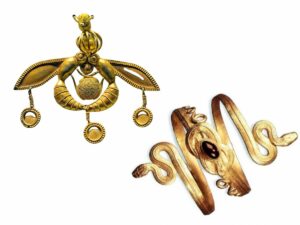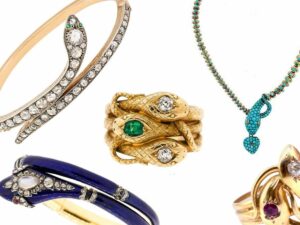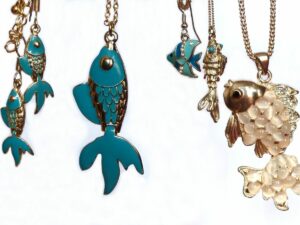Animal elements hold a significant position in the history of Chinese culture and the development of art, leaving a unique imprint on the spiritual world of individuals since ancient times. Animal imagery is present in various art forms, and there is a growing adoption of animal elements in decorative crafts.
This article explores the incorporation of animal elements in jewelry design, examining the evolution of these elements and their integration with jewelry design. Through this analysis, the article seeks to uncover new ideas and inspirations for contemporary jewelry design.
1. Motivation and Cultural Connotation of Animal Elements
The utilization of animal elements in decorations has deep roots in ancient times. During this era, productivity was low, and the lives of people were closely entwined with various animal groups. The danger and aggression posed by animals instilled a sense of fear or admiration in the human heart, leading to the formation of totem worship.

Simple images of animals were carved on essential survival tools (e.g., stone tools, stone pots) used by people. Furthermore, dependence on animals for food ingrained a sense of respect and reverence for these creatures in the hearts of ancient humans. This reverence, combined with the perceived natural connection between humans and animals, fostered a belief that humans were descended from animals.
Additionally, some inexplicable natural laws observed in the course of production and daily life were associated with specific animal characteristics, leading to a belief in a deep, mystical connection between animals and gods.
The prevalent use of animal elements in jewelry crafts is attributable to the intrinsic allure of animals and the meanings ascribed to animal imagery by people. These images, endowed with connotations of auspiciousness and beauty, convey good wishes to both the wearers and observers, reflecting a rich cultural heritage.
2. Expressing Animal Elements in Jewelry Design
| Method |
Example Application |
Best Practices |
| Simplification Method |
Bird elements with basic body shapes |
Maintain key characteristics; avoid detailed depictions to keep focus on overall outline |
| Personification Method |
Combining human faces with animal bodies |
Ensure logical anthropomorphism; maintain the animal’s inherent habits and characteristics |
| Hyperbole Method |
Emphasizing the robust heads of tigers or lions |
Avoid crude, unrefined copying; accentuate specific features to convey strength and power |
Simplification Method
This approach involves simplifying and abstracting animal forms by condensing their shapes and omitting minor parts. During the design process, it’s crucial to maintain the overall outline while emphasizing key animal characteristics.
For instance, when designing with bird elements, a simple representation of the bird’s body shape is sufficient. Roughly sketching the key features enables the viewer to identify the bird type without detailed depiction.
Personification Method
This widely used technique involves imbuing animal elements with human characteristics, often observed in precious metal designs (like those incorporating pearls, gems, or gold). The process of anthropomorphizing animals, such as combining human faces with animal bodies, enhances the intrigue and artistic value of the piece.
However, when employing this method, designers should ensure the anthropomorphism is logical and still reflective of the animal’s inherent habits and characteristics. This approach should not confuse viewers but rather serve as a basis for understanding the piece.
Hyperbole Method
This technique extends the concept of emphasizing by strongly highlighting specific animal parts while blurring or weakening others to accentuate certain features. Hyperbole seeks to introduce novelty and delight through modification and exaggeration.
In the design process, it is advised to move away from crude, unrefined copying methods. For example, when designing pieces featuring tigers or lions, it is essential to accentuate the robust outlines of their heads to convey a sense of strength and power to the viewer.
3. Design Features and Expressions of Common Animal Elements
Bird and Beast Shapes
Birds and beasts play a dominant role in the decorative arts of my country, stemming from their deep connection with people’s innate cognition, memories, and emotions. Through observation and imitation of these creatures, they’ve been externalized in art, with some eventually becoming revered totems deeply embedded in people’s consciousness.
Elements like tigers, birds, deer, and eagles in jewelry design are concrete manifestations of this dominance.
Over different periods, various artistic expressions have emerged, with techniques such as relief or inlay being used to blend the figure of a tiger with background patterns seamlessly. Examples of exquisite application of these elements in jewelry design include the Cartier Exotic Series (Bengal Tiger) and the Swarovski Chinese Zodiac Series.
Snake Shapes
The snake element has been crucial in jewelry design since ancient times. While birds and beasts evoke special emotions among the Chinese, snake elements resonate emotionally with Western societies. For instance, ancient Egyptians worshipped snake totems.

The snake’s unique rhythm and dynamic beauty offer visual novelty and excitement, not adhering to conventional design paradigms but exhibiting rich variability.
The application of snake elements is usually through gemstones of different colors set on various metal materials, with graceful and smooth shapes summarizing and deforming certain morphological characteristics of snakes. Italian Bulgari jewelry design is a classic example of the use of snake-shaped elements.
Marine Animal Modeling
The abundant and diverse marine life offers a fertile ground for jewelry design. Early designs, mainly simple and symmetrical, have evolved with people’s growing cognitive levels to incorporate three-dimensional patterns and a variety of materials, enhancing the vibrancy of marine life representations.

For instance, octopus, known for its rhythm and unique characteristics, is often designed using 3D technology with different colored gemstones to achieve a visually integrated effect. Pieces like those launched by Boucheron and Tiffany, known for their vibrant colors and dazzling combination of stones, are increasingly favored by jewelry enthusiasts.
Animal elements hold a special aesthetic appeal for various reasons. As people’s aesthetic visions expand and diversify, the realm of jewelry design broadens, allowing designers to innovatively use animal elements to highlight the uniqueness and personality of each piece, bringing constant innovation and a fresh breeze to the decorative arts.



